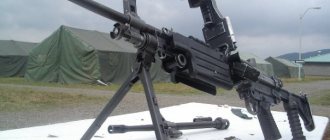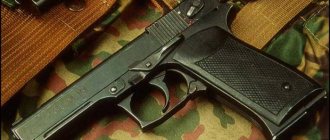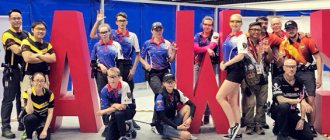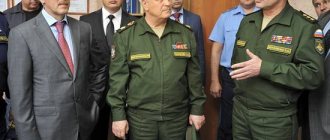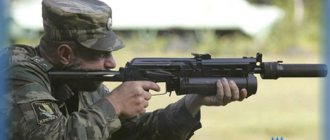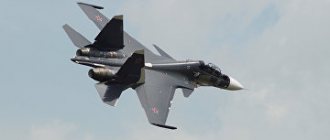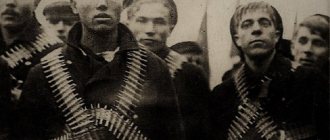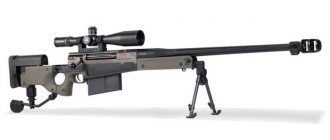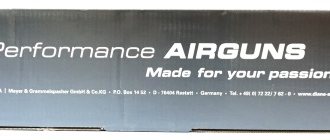Japanese Type-89 BMP
The development of an infantry fighting vehicle for the Japanese Army (Self-Defense Forces) began in 1981, when funds were allocated for this purpose. According to the Courage 2004 website, four prototypes were assembled in 1984. Tests of the infantry fighting vehicle, called Type-89 (“Type-89”), were planned to be completed in 1989. The total order quantity is 320 vehicles.
A characteristic feature of the vehicle’s layout is that the driver is located not on the left, as is done in most existing infantry fighting vehicles, but on the right front part of the hull. Accordingly, the MTO is located to the left of it. A double turret with power drives is installed in the middle part of the vehicle. In it, the commander's workplace is equipped on the right, and the gunner's on the left of the gun. At the rear of the hull there is a room for infantrymen (landing compartment). The sides of the hull have embrasures with ball mounts (3 on the left side, 2 on the right side and 1 in the aft hatch), intended for firing from personal weapons. A large hatch with a double-leaf lid is mounted in the roof of the troop compartment. The roof also contains periscope devices used by infantrymen for observation and shooting. In the stern sheet there are large doors for the entry and exit of the landing force.
The main armament of the vehicle is a 35-mm Swiss KDE automatic cannon, which has a rate of fire of 200 rounds/min. The first samples of the vehicle were equipped with Swiss-made guns, but after the vehicle was put into service, the production of guns was organized in Japan under license under the designation L90. A 7.62 mm machine gun located to the left of it is paired with the cannon. In addition, the vehicle uses additional guided weapons: one launcher of guided medium-range anti-tank missiles is placed on the sides of the turret. Reloading of PU missiles is done manually. ATGMs of national design are produced. To launch smoke grenades, 6 grenade launchers are used, located on the sides of the turret in two blocks.
For observation and shooting, the gunner uses a periscope sight installed in front of his hatch and two prisms oriented forward and to the left. The commander also has a periscope sight. To provide it with all-round visibility, 6 prisms are installed. The fire control system also includes a thermal imaging sight and a laser rangefinder.
The car uses a diesel engine with a power of 441 kW (600 hp). The chassis contains (on board) 6 gable rubber-coated support rollers and 3 support rollers, torsion bar suspension with hydraulic shock absorbers. Drive wheels in front, guide wheels with track tensioning mechanisms at the rear. The chassis is covered with folding anti-cumulative screens.
The machine is equipped with a filter-ventilation unit and a fast-acting PPO.
——
American footprint in tank building in the Middle Kingdom
Israeli weapons killed Ossetian civilians and Russian peacekeepers
The Ukrainian army will soon receive the first 10 Oplot M tanks
The Chinese captured the T-62 tank at Damansky and tried to copy
US-China tank love ended in Tiananmen Square
“China syndrome” on board a Russian nuclear-powered ship
'Deadly and invulnerable' Abrams goes digital
The Chinese are equipping old tanks with thermal imagers and guided missiles
Tank "Type 59": Nizhny Tagil roots of Chinese tank building
Ukrainian tank "Oplot M" is superior to the Russian T-90A
The Chinese created tanks to attack Taiwan
Russian missile hits Georgian military command tank - tank for beggars
Greece has everything. Even the Centauros infantry fighting vehicle
Russia wants to help India create a new generation of armored vehicles
Combat vehicle for Chinese landing
Soviet tanks were supposed to enter Poland. But Jaruzelski prevented this
In the battles at Khalkhin Gol
“Vodnik”, “Tiger” and “Pecheneg” fought against Saakashvili’s army
The Poles never completed their BWP-2000 infantry fighting vehicle
BMP VCTP: in the rhythm of Argentine tango
Tanks of the Georgian army
Russian “museum” T-62s fought against modernized Georgian T-72s
Russian troops used unmanned reconnaissance "Bees" in Georgia
Russian citizens were killed with German weapons
The Russian army used “museum” tanks in the war with Georgia
Bulgarian brothers made an infantry fighting vehicle from what they had
The T-90 will be in demand on the arms markets for decades to come
The newest Russian BTR-90 with a unique Bakhcha weapon system
"Puma" - BMP of the 21st century
BTR-90 with the Berezhok weapon system
Who destroyed the Russian supertank of the 21st century
In China, the QSZ-92 pistol will replace the Makarov and Tokarev
In the homeland of Dracula, the Russian BTR-80 was “mutilated”
The Chinese tried to clone "Joseph Stalin"
Domestic armored vehicles meet the most modern requirements
Chinese army jeep BJ2020S - a synthesis of Soviet and American technologies
An old horse does not spoil the furrow: T-62 tanks in battles in the North Caucasus
China is arming itself with an unusual caliber machine gun
The new modification of the T-80 had no equal in gun caliber
BMD-4 combat vehicle of the future in the present
The Russian Marine Corps dreams of the BMP-3F
Yugoslav BMP M-80 - “Milosevic’s tin can”
The best tank was created in the Urals
Chinese Type 89 heavy machine gun
The experience of military conflicts shows that the role of large-caliber machine guns in the range of weapons of fire destruction not only does not decrease, but even grows. At the same time, the requirements for their maneuverability and “versatility” have increased.
Large-caliber machine guns in the easel version are required to be able to follow small units in various combat conditions and on different terrain, and transfer them by various means, including light vehicles and light transport helicopters. On the other hand, a heavy machine gun should be easily mounted on tanks, armored personnel carriers, and naval installations.
PATH TO TYPE 89
In China, the development of a light heavy machine gun - more mobile than the Type 54 (Chinese copy of the Soviet DShKM) - began back in the 1970s. Focusing on the same powerful cartridge of the 12.7 x 108 DShK type.
The acceleration of work on this topic was apparently facilitated by the appearance of the Soviet light machine gun NSV-12.7 and information about American work on the GPHPMG project. In any case, since the late 1980s, a number of new Chinese 12.7 mm models have been consistently introduced - Type 77, which weighed 56.1 kg on a tripod. Type 85 (W-85) with a tripod weight of only 39 kg. At the end of the 1980s, development began on the next, most lightweight model. Ultimately, this machine gun was introduced under the designation Type 89.
Read: Ross Rifle
The 12.7 mm Type 89 machine gun is designed to combat air targets at slant ranges up to 1500 m, as well as lightly armored ground targets, vehicles, and group live targets at effective firing ranges up to 1500 m. Some units of the People's Liberation Army of China have already received the Type 89 machine gun as a battalion or company support weapon. At international exhibitions it was also presented under the “Latinized” designation QJZ 89.
DESIGN
The automatic operation of the machine gun has a mixed design using gas (gas exhaust) and recoil engines; the barrel bore is locked by turning the bolt. To unlock the bolt, a gas vent drive is used to remove powder gases through a gas chamber and a long gas tube located under the barrel directly to the bolt frame, without using a gas piston. After unlocking, the barrel with receiver, bolt carrier and bolt, which make up the moving system, continue to roll back inside the stationary box under the influence of the remaining recoil impulse. To perform reloading, it is necessary to accelerate the movement of the bolt frame relative to the barrel - this problem is solved by a lever accelerator, which transfers to the bolt frame most of the kinetic energy of the moving system. As a result, the barrel and receiver make a very short rollback. “Stretching” the recoil effect over time and increasing the mass of the recoil parts, combined with the use of a muzzle brake, made it possible to significantly reduce the impact of the recoil impulse of a powerful cartridge on the weapon and installation. This, in turn, contributes to the accuracy of burst fire with a reduced weight of the weapon itself.
Read: Design of the Heckler & Koch P9 pistol
The machine gun barrel is quick-change, with longitudinal valleys on the outer surface of the barrel to increase rigidity and better cooling. A two-chamber muzzle brake is attached to the muzzle of the barrel. To make it easier to change the barrel and carry the weapon, the barrel is equipped with a handle. A frame stock with a shock absorber and a pistol control grip are attached to the machine gun box, making it more convenient to hold the machine gun when aiming and firing. An optical or night sight is installed on the machine gun; a mechanical sighting device serves as a backup.
The cartridges are fed from a standard link cartridge belt with an open link, assembled from pieces of 10 links and placed in a box. The direction of feed of the tape is from left to right. For firing a machine gun, Type 54 and Type 84 cartridges with armor-piercing incendiary bullets, Type 89 with an armor-piercing incendiary tracer bullet, Type 89 with a high-explosive incendiary bullet, as well as a cartridge with an armor-piercing sabot bullet are used.
INSTALLATIONS
The main installation for the Type 89 machine gun is a folding tripod, used as a universal one. Shooting from the machine at ground targets is possible from a prone, kneeling or standing position, and at air targets - from a kneeling or standing position. The legs of the machine are equipped with burrowing coulters. The swivel of the machine allows circular guidance and is equipped with a clamping device. The crew of the machine gun in the easel version is three people. Two crew numbers can carry a machine gun with a machine and a cartridge belt onto the battlefield, holding it by the butt and barrel handle.
Read: Springfield rifle (USA)
Also, the machine gun can be installed on combat vehicles in various installations; a ship (deck) pedestal installation with an armored shield is also presented.
You might be interested:
- NSV-12.7 "Cliff"
- Machine guns - ways of development
- DShK machine gun
- 13.3 mm MG.18 (TuF) machine guns - the first large-caliber
- Large-caliber machine gun "Kord"
- Heavy machine guns between the world wars
Subscribe to
our channel in Yandex.Zen
Type 96A main battle tank (ZTZ-96A)
Return to Type 96 (ZTZ-88C)
At the turn of 2005-2006, production of a modernized tank began in China, designated ZTZ-96A (originally designated ZTZ-96G). The main directions of modernization were: strengthening ballistic protection, boosting the engine, installing a new fire control system ISFCS-212B with a digital ballistic computer GUMS-2 and a thermal imaging sight for the gunner. The new sight has a wide field of view with a magnification magnification of x3, and a narrow field of view with x8, as well as independent stabilization. The armor was strengthened by installing additional FY-4 type remote sensing modules on the frontal part of the turret, as well as around its aft niche and on the upper frontal part of the hull. This circumstance gave the tank an appearance similar to the Type 99 . The tank was supposed to be equipped with the JD-3 anti-ATGM system, which is a copy of the Russian Shtora-1 system that the Chinese apparently purchased from Ukraine. However, the JD-3 complex is not installed on production tanks in military units.
The installation of additional armor and other additional improvements led to an increase in combat weight to 43.7 tons. In this regard, the 12150ZL diesel was replaced by a more powerful 12200ZL model, which according to some reports develops 735 kW at 2500 rpm. However, according to other sources, the power of the forced engine is actually only 800 hp, and claims of 1000 hp. more like an advertisement.
The transmission is five-speed manual, as on the original modification of the tank. The track tracks also remained the same, but according to some data, in the future they may be replaced with newer ones, similar in design to the Type 99 with asphalt shoes.
the Type 96A tank remained unchanged - a 125 mm smoothbore gun, a coaxial 7.62 mm and a 12.7 mm anti-aircraft machine gun. Due to the rearrangement of the fighting compartment, the gun's ammunition supply was reduced by 2 rounds - now there are 40 of them (including 22 in the automatic loader). In addition to conventional shells, the tank can fire laser-guided anti-tank missiles (a licensed copy of the Russian 9M119 Reflex) through the gun barrel with a range of 100 to 4000 m. To set up aerosol curtains, smoke grenade launchers are mounted on the sides of the turret.
For external communications, the Type 890C radio station is used (frequency range from 28 to 90 MHz), and for negotiations between crew members, the VIC8 intercom is used.
Type 96A tanks (ZTZ-96A) were publicly shown at a military parade in Beijing on October 1, 2009, on the occasion of the 60th anniversary of the People's Republic of China. They are now in service with PLA units along with the Type 96. Since 2005, these vehicles have been participating in various international exercises, including the SCO Peace Mission in Chebarkul, and in 2014 they took part in a tank biathlon ( see detailed photo report >>> ), where they attracted everyone's attention.
The Type 96A tanks also achieved some success in terms of exports - about 200 vehicles were sold to Sudan. They were first demonstrated under the name "Al-Bashira" at a military parade in Khartoum at the end of 2007 in honor of the 52nd anniversary of Sudan's independence. True, the Sudanese army became the first and so far the only one where the Chinese were able to supply Type 96A .
| Tank "Type 96A" at the tank biathlon, 2014 (photo report) |
| MAIN CHARACTERISTICS | |
| Combat weight, kg | 43 700 |
| Crew, people | 3 |
| Main dimensions, mm: | |
| — Body length (with gun forward) | 6600 (9070) |
| - Width | 3410 |
| - Height | 2300 |
| — Clearance | 480 |
| — Base x Track | no data x 2700 |
| Average specific ground pressure, kg/sq.cm | 0,9 |
| Armament (ammunition, shots): | |
| — 125 mm smoothbore (copy 2A46) — 7.62 mm Type 86 machine gun — 12.7 mm QJB-86 anti-aircraft machine gun | 1 (22+18) 1 (2250) 1 (500) |
| Vertical guidance angles, degrees. | -4…+12 |
| Sights | periscope combined gunner (with thermal imager) and commander with stabilization, laser rangefinder |
| Weapon stabilizer | two-plane |
| Loading mechanism | There is |
| Means for setting up smoke curtains | 2x6 grenade launchers |
| Engine type and brand | diesel NORINCO 12200ZL, 12-cylinder |
| Maximum power, hp | 800 |
| Specific power, hp/t | 18,7 |
| Fuel tank capacity, l | 1000 (+400) |
| Transmission | mechanical |
| Maximum speed, km/h: | 57 |
| Cruising range, km | 400 (600) |
| Obstacles to be overcome: | |
| - ditch, m | 2,7 |
| — wall, m | 0,8 |
| - ford, m | 1.4 (5 with OPVT) |
| Reservation, mm | combined |
Sources used: “Military equipment and weapons of China. Tanks." L. Karyakin, V. Moiseev; "ATM" No. 7/2015; "Chinese Defense Today"
Join our group “Courage 2004”
Share on social networks:
Notes[ | ]
- The first grenade launchers were produced at a Ukrainian plant // “Arguments and Facts - Ukraine” dated October 18, 2013
- UAG-40 on the website Sergey Wei. The Ukrainian enterprise "Leninskaya Kuznya" began production of UAG-40 automatic grenade launchers // "Military Industrial Complex News" dated July 4, 2011
- ↑ 12
Ukrainian developers have created a new combat module and called it “cyborg” (photo) // UNIAN dated January 24, 2015 - ↑ 123
Ukraine began producing weapons according to NATO standards // “Arguments and Facts - Ukraine” dated January 30, 2015 - Poroshenko will assemble grenade launchers for the Ukrainian army Archived copy dated April 27, 2014 on the Wayback Machine // NEWSRU.UA dated October 1, 2013
- Victor Myasnikov. Ukraine has created a Belarusian grenade launcher // Nezavisimaya Gazeta, November 1, 2013
- Poroshenko begins production of grenade launchers Archived copy dated June 23, 2020 on the Wayback Machine // “The Kiev Times” dated October 1, 2013
- Alexander Alexandrov. Grenade launcher - an accurate mechanism // "Red Star", No. 14 (26474) dated January 29, 2014. p.6
- Repair and modernization of equipment - BRDM-2 (inaccessible link) // official website of Techimpex LLC
- KB "Precise Mechanisms" successfully solved the problem of installing an optical sight on the UAG-40 grenade launcher // "Defense express" dated February 7, 2014
- PJSC "for the first time presented a new combat module MBM // "Ukraine Industrial" dated September 26, 2014
- White Book 2020: The Armed Forces of Ukraine. Kiev, “Ministry of Defense of Ukraine”, 2020. page 49
- AGS-40
- Mk.47 mod.0
- HK GMG
- 40mm Y3 MK1 Automatic Grenade Launcher
- Daewoo K4
- Howa Type 96
Device[ | ]
UAG-40 operates on the principle of using the recoil energy of the free-running shutter. The ammunition used is 40x53 mm NATO standard grenades in M16 metal strip.
The grenade launcher is controlled by two handles located at the rear of the body or by one handle and a shoulder rest. For the convenience of the shooter, the handles can occupy both horizontal and vertical positions. The right handle is equipped with a trigger button, which has two modes - for single shots and for firing in bursts. The release button and shutter are equipped with safety locks that prevent accidental shooting.
To reduce the recoil impulse, the UAG-40 is equipped with a friction bolt damper and a slotted muzzle brake.
The design of the weapon allows firing from unprepared positions.
UAG-40 can be installed on a tripod machine, or installed using an adapter on an armored vehicle or ship.
- in September 2010, the Cossack armored car was presented with a UAG-40 grenade launcher mounted on the roof.
Comparison of UAG-40 with analogues[ | ]
| UAG-40 | AGS-40[14] | Mk.47 mod.0[15] | HK GMG[16] | Vektor Y3 AGL[17] | SB LAG 40[en] | Daewoo K4[en][18] | Howa Type 96[en][19] | |
| Appearance | ||||||||
| Years of production | since 2010 | since 2008 | since 2003 | n/a | since 2007 | n/a | since 1992 | since 1996 |
| Caliber, mm | 40 x 53 | 40 mm caseless | 40 x 53 | 40 x 53 | 40 x 53 | 40 x 53 | 40 x 53 | 40 x 53 |
| Tape, shots | n/a | 20 | n/a | 32 | n/a | 24/32 | n/a | 50 |
| Weight, kg: general grenade launcher body[SN 1] | 17,0 31,0 | n/a 32 | 18,0 41,0 | 29,0 46,5 | 18,0 33,1 | n/a 34.0 | 35,3 65,9 | 24.5 n/a |
| Barrel length, mm | 400 | 400 | 330 | 577 | 335 | 415 | 412 | 454 |
| Grenade launcher length, mm | 960 | n/a | 940 | 1175 | 861 | 960 | 1094 | 975 |
| Rate of fire, rounds/min | 400 | 400 | 225—300 | 340 | 280—320 | 215 | 350 | 250—350 |
| Initial speed of the grenade, m/s | 240 | 240 | n/a | 245 | 240 | 242 | 240 | n/a |
| Aim | mechanical (base), optical or optical-electronic (optional) | PAG-17 | AN/PWG-1[sn 2] | n/a | optical or electronic (ballistic computer) | n/a | n/a | n/a |
| Maximum firing range, m | 2200 | 2500 | 2200 | 2200 | 2200 | 2200 | 2200 | n/a |
Footnotes
- Weight with machine and sight without cartridge box (tape)
- The AN/PWG-1 sighting system includes a daytime television channel with 3x magnification and image output on a built-in display, a laser rangefinder and a ballistic computer. The sight also has an interface for connecting to it a night sight operating in the IR range, with the image of the night channel displayed on the display.
Howa Type 89. Our own “alien” rifle
Howa Type 89R, or Para (that is, with a folding stock)
Both the winner and the vanquished, In the playground of this world - No more than a drop of dew, No longer than a flash of lightning. Ouchi Yoshitaka (1507-1551)
Weapons and companies.
And it so happened that, having suffered a crushing defeat in World War II, Japan experienced terrible national humiliation. Essentially, the country was crushed - in every sense. In 1950, in terms of its level of economic development, it was on the same level as Egypt. However, it developed its own military, and the Korean War revitalized its economy. And the “Japanese miracle” began, a miracle primarily of borrowing and modernization, and the borrowing of everything and everyone also affected the Japanese armed forces.
Iwo Jima Island, 2007. An American instructor shows a Self-Defense Forces fighter rifle techniques. Japanese soldier (left) armed with a Type 64 rifle
In the mid-1950s, the command of the Japanese Self-Defense Forces decided to replace the American M1 Garand rifles and M1 carbines that were in their arsenal. In March 1956, Japan and the United States signed a Standardization Agreement, as a result of which the 7.62x51 mm NATO became the new standard cartridge of the Japanese army, but with a charge reduced by 20% and a muzzle velocity reduced by 10%. But the return also decreased, which was of great importance for the short and weak post-war Japanese. In the same year, General Kijiro Nambu and Colonel Kenzo Iwashita at the Howa Machinery Company Ltd, located in Nagoya, began work on a new rifle chambered for this cartridge. However, it was only possible to create it in 1964, and then it was put into service under the designation Type 64. The production of Type 64 rifles was carried out at an enterprise in the village of Shinkawa (today the city of Kiyosu) until 1988. One of the most noticeable features of this rifle was the open bolt with a charging handle mounted on top of it, and the ability to automatically switch firing from the front to the rear sear when the barrel overheated.
Japanese soldier with a Type 64 rifle in the jungle...
...and in the grass
The rifle went into service, but then the Vietnam War began, and the US Army began replacing the 7.62 mm M14 rifles with the 5.56 mm M16. Less weight and standard NATO ammunition - all this was very tempting, since the Type 64 was criticized by many for its high metal consumption and weight.
Due to the design of the bolt for the Type 64 rifle, it was necessary to develop a non-standard sniper scope mount and, in addition, it became not very convenient to use with it!
Howa already had a license at this time to produce the AR-180 rifle, a commercial version of the Armalite AR-18 rifle. A batch of rifles were produced for field testing, and when they gave positive results, official development began on a new generation assault rifle designated HR-16 (HR1604), which eventually became the "Type 89" since it was developed in 1989.
AR-180
One of the most advantageous features of the Type 89 rifle compared to the Type 64 was the reduced burden on the soldier and the increase in the amount of ammunition he could carry. In addition, thanks to the use of aluminum and plastic, in contrast to the steel and wooden structure of the Type 64 rifle, the weight of the rifle itself was reduced, that is, it became more convenient to handle.
The fixed stock version of the rifle has a rubberized storage container inside it. Although the standard model is equipped with a fixed stock, a small number of rifles have a folding stock. Such rifles are made for armored vehicle crews and paratroopers.
"Type 89 Para" with folding stock. Right view
The rifle is believed to be at least as accurate as the Type 64 rifle, meaning they are equal in terms of accuracy. The Type 89 rifle is equipped with a built-in bipod, like its predecessor, to improve shooting accuracy. However, unlike the bipod on the Type 64 rifle, the bipod on the Type 89 is easily removable as it is attached to the barrel by a spring mechanism and held in place by a lever lock. In addition, the Type 89 handguard is designed so that the bipod legs fold inward.
The rifle's design was directly related to designs such as the AR-18 and the Heckler & Koch G3. In addition, since the rifle was designed from the very beginning to suit the physique of Japanese soldiers, its creators adjusted all the ergonomic and weight characteristics specifically to them.
The complex design and large number of parts of the Type 64 rifle often became the reason for failures in its operation. Therefore, the number of parts on the new sample was reduced. Because of this, the cost of the Type 89 rifle became approximately half that of the Type 64 rifle. Moreover, if in 1989 it cost 870,000 yen, then in 2005 its price decreased to 340,000 yen. Despite this, it is still considered too expensive for a mass-produced weapon, since the ideal price, according to the Japanese government, should be in the range of 10,000 to 100,000 yen per copy and no more.
"Type 89". View left and right
The Type 89 rifle ammunition is interchangeable with the SS109/M855 5.56×45mm cartridge used by the US and NATO militaries. Along with the 7.62×51mm cartridge, this provides full interchangeability with the ammunition stocks of US Army units stationed in Japan. The only difference is in the markings: since the ammunition developed for the Type 89 rifle is manufactured in Japan, it is stamped with the Self-Defense Forces cherry blossom instead of the typical NATO cross used in the SS109/M855 cartridges.
Bolt handle, 4-position fire selector and diopter sight
The rifle has a traditional gas-operated mechanism, but the Japanese would not be Japanese if they had not modernized it at least a little. In this case, they made the front part of the piston somewhat narrower than the diameter of the gas cylinder, and even placed it at some distance from the gas outlet. As a result of this innovation, the energy of gases works in two stages: the initial impulse is received, as usual, by the head of the gas piston, but since the “maximum” pressure does not build up in the cylinder immediately, it turns out that it reaches its maximum when the piston is already moving. That is, there is no push, and since there is no push, the rifle mechanism works more smoothly, and this reduces its wear. Such a “small” little thing, but nice!
The Type 89 can use M16 rifle magazines. However, the magazine produced specifically for the 89 rifle has a special pusher that prevents the bolt from closing after all the cartridges in the magazine have been expended. If an M16 series magazine is used, the bolt will close in any case. Japanese magazines have four holes that allow you to control the consumption of cartridges. But many people think that this is inconvenient, since the holes allow sand and any other foreign objects to easily get into the magazine and cause delays when firing.
It is believed that the magazine receiver's bevel is also insufficient compared to the M16, which is bad because it increases the time required to reload the rifle in certain combat situations.
Rifle with M16 magazine
The selector switch is located on the right side of the receiver and has four positions, including fire with a three-shot cutoff.
The rifle bayonet can be used as a wire cutter by combining it with the scabbard, and the scabbard itself, or rather its tip, can be used as a bottle opener. The American M9 bayonet can also be attached to this Japanese rifle. A Type 06 rifle grenade has been developed for the rifle. The American M203 grenade launcher can also be installed on it, but with the appropriate adapter.
A whole range of long-lasting accessories are also suitable for the rifle, but soldiers must, or rather have the right, buy them at their own expense! Even those to whom they are issued must reimburse their cost by paying the quartermasters money from their salaries.
There were attempts to make a shortened version of this rifle, that is, a “carbine” with a total length of about 800 millimeters, with four Picatinny rails. An aiming system was also developed, which includes a rangefinder and a video camera, which allows you to keep the rifle at a distance from you and still shoot from it. But there is no talk of replacing the Type 89 rifle yet.
